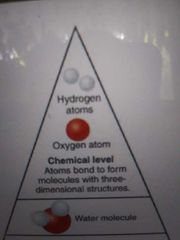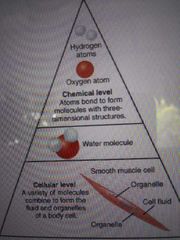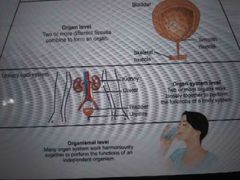![]()
![]()
![]()
Use LEFT and RIGHT arrow keys to navigate between flashcards;
Use UP and DOWN arrow keys to flip the card;
H to show hint;
A reads text to speech;
23 Cards in this Set
- Front
- Back
|
Human Anatomy |
The scientific study of the body structure |
|
|
Physiology |
The scientific study of the chemistry and physics of the structures of the body. Physiology explains how the structures of the body work together to maintain life |
|
|
Structural organization of the human body |
These include the chemical, cellular, tissue, organ, organ system, and organism level.
Molecules combine to form cells. Cells combine to form tissues. Tissues combine to form organs. Organs combine to form organ systems. Organ systems combine to form the organisms/human body |
|
|
Regional anatomy |
Study of the structures that contribute to a specific body region |
|
|
gross anatomy |
Study of the larger structures within the body macroscopic Anatomy |
|
|
Microscopic Anatomy |
The study of structures that can be observed with a microscope |
|
|
Systemic Anatomy |
The study of the structures that contribute to a specific body system |
|
|
Homeostasis |
The steady state body systems that living organisms maintain |
|
|
Atoms |
Atoms are made up of protons electrons and neutrons |
|
|
Molecule |
Two or more atoms combine to form molecules such as water sugar and protein found in living things. Molecules are the chemical building blocks of all body structures |
|
|
Six levels of structural organization of the human body Chemical level |

Chemical level: atoms bond to form molecules with 3-d structures |
|
|
Cellular level |

A variety of molecules combine to form the fluid and organelles of a body cell |
|
|
Tissue level |

Tissue level. A community of similar cells form a body tissue |
|
|
Organ level |

Two or more different tissues combine to form an organ |
|
|
Organ system level |

Two or more organs work togther to form the function of body system |
|
|
Organismal level |

Everybody working in harmony |
|
|
11 organ systems |
Integumentary system Skeletal system Muscular system Nervous system Endocrine system Cardiovascular system Lymphatic system Respiratory system Digestive system Urinary system male reproductive system Female reproductive system |
|
|
Metabolism |
Is the sum of all anabolic and catabolic reactions that take place in the body |
|
|
Catabolism |
Catabolism is the process where a large complex substances-- like food are broken down into smaller substances. Like fat carb and protiens. they release energy or ATP |
|
|
Anabolism |
Anabolism takes simple fat carbs proteins that have been broken down by digestion and build them up into more complex molecules to fuel the body and store them. ATP is used to create the energy |
|
|
ATP |
Every cell in your body makes use of a chemical called ATP to store and release energy anabolism then move the ATP molecules to the location where energy is needed to fuel cellular activities. Then the ATP is broken down and I control the amount of energy is released |
|
|
Responsiveness |
The ability of the organism to adjust to change in his internal and external environment. We move towards water and away from danger |
|
|
Movement |
Not only includes action of the joints but also the Motions of individual organs and individual cells |

